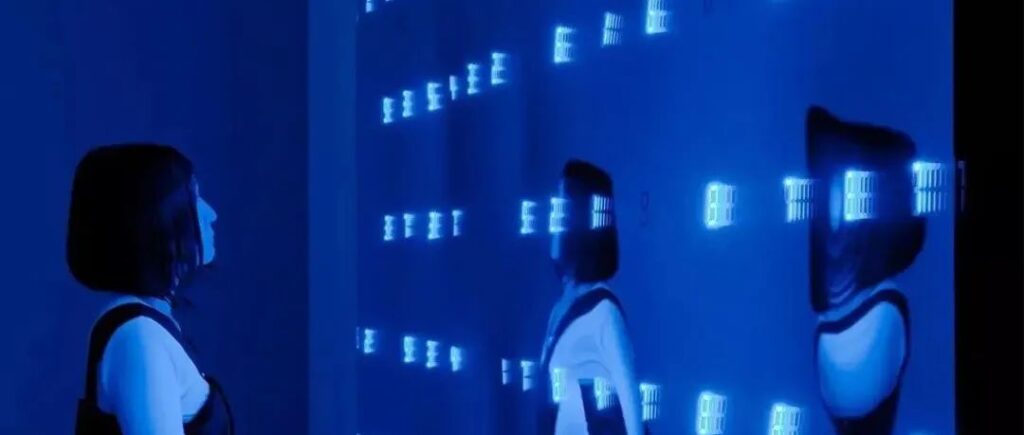宫岛达男Tatsuo Miyajima|用数字体会生死 Experience life & death with numbers
About artist
关于艺术家

Tatsuo Miyajima, who was born in Tokyo’s Edo district in 1957, grew up in Japan’s most wealthy area with a strong urban culture, which informs his works about human nature and urban thought. In the early years of his career, he focused on avant-garde performance, which ignited his interest in installation construction, physical space exploration, and the riddles of time.
宫岛达男 1957年出生于东京江户区,在日本最富裕的地区长大,有着浓厚的城市文化,这为他的作品提供了关于人性和城市思想的信息。在他职业生涯的早期,他专注于前卫的表演,这激发了他对装置建造、物理空间探索和时间之谜的兴趣。
In the 1980s, he shifted his concentration from performances to site-specific installations and sculptures, primarily employing displays and LED systems to represent his topics with a minimalist approach. Tatsuo Miyajima released his work with light-emitting diodes for the first time in 1987. “Sea of Time“, which was shown in the Young Artists Section of the Venice Biennale the following year, received widespread worldwide praise. He has become one of the representatives of Japanese post-mono school artists.
在 1980 年代,他将注意力从表演转移到特定地点的装置和雕塑上,主要使用显示器和 LED 系统以极简主义的方式表现他的主题。1987年,宫岛达夫首次发表了他的发光二极管作品。次年在威尼斯双年展青年艺术家单元展出的《时间之海》获得了世界范围内的广泛赞誉。他已经确立了自己成为目前日本后物派艺术家的代表之一。
“Mega Death”
《幻灭》
Numbers are not only used and calculated in mathematics, but also in artistic imagination, connected with the philosophy of life and rational thinking.
数字不仅在数学中使用和计算,而且在艺术的想象中,与生活哲学和理性思维相联系。


Numbers are everywhere in our life. The alarm clock that wakes me up in the morning; my bank account balance; turning a year older each year; essential anniversaries, and so on. Do these numbers have any significance for you?
数字充斥着我们的生活。早上叫醒我的闹钟;银行户口的余额;每年都大一岁的年纪;特别的纪念日等。这些数字对于你有又什么特别的意思吗?
Numbers symbolize life and death in the case of Tatsuo Miyajima. “Mega Death”, his 1999 piece, comprises 2,400 glowing blue counters. The installation is repeated from 1 to 9. Although our age is growing, our life expectancy is decreasing. Therefore, he intends to depict human life’s death and rebirth via the reciprocal repetition of numbers.
就宫岛达男而言,数字代表了生命和死亡。《幻灭》是他1999年的作品,这个装置艺术是由2400个发蓝光的计数器组成的。装置重复着数字1至9,虽然我们的年纪在增长,但是寿命却在倒数,这就是他希望透过数字的倒数和重复,表达人类生命的死亡和轮回。
Consider the twentieth century’s multiple wars, revolutions, and diseases. Every day, someone dies or gives birth to a new life. The initial wall was black, and every blue light that turned on lit the gloomy world like a new life, yet life was finite, and it was stifling when the light went out at the end. When the lights come back on, it’s like starting over.
反观20世纪的各种战争、革命和疫情。每天都有人面对死亡或者是新生命的诞生。原本的墙面是黑暗的,每一盏亮起来的蓝灯,就像新生命一样把黑暗的世界照亮,但生命有限,到最后灯熄灭了的那瞬间,让人窒息。当灯再次亮起的时候,又有重获新生的感觉。

It sounds like the Buddhist theory of life and death, yet in Buddhism, death is presented as the beginning. Buddhists believe that reincarnation occurs. Tatsuo Miyajima is a Buddhist, and from his childhood experiences and Buddhist philosophy, he established his own “digital and creative existence.” As a result, this philosophy has profoundly inspired his work, transforming him into an artist who balances reason with intuition.
听起来好像佛教的生死哲学,佛教所解说的死亡其实也是开始。佛教徒相信生命是有轮回的。宫岛达男是佛教徒,他小时候的经历以及在佛教的哲学思想下,创造了他自己的“数字和艺术人生”。因此,这个理念也深深的影响了他的创作,使他成为了理性和感性并存的一个艺术家。
But why didn’t he just use 0?
但是,为什么他没有用到0?
This is done on purpose. Because Buddhism has a concept of “emptiness,” it is analogous to 0, which may imply limitless or nothing. A 0 can also represent something that has ended and no longer exists, such as a 0 on the pacemaker of a patient who died in a hospital. As a result, there is only a cycle of 1 to 9, which represents endless existence.
这是故意为之。因为在佛学中有“空”的概念,和0很像,0可以是无限也可以是无有的意思。0也像是一件事到了尽头,没有再存在的表现,像医院里死亡的病人的心跳起搏器上显示的0。所以,只有1至9的循环,象征了永恒的生命。
Counter Sky Garden
数字空中花园
“Although the mediums and props used in installation and performance art are different, as long as the core concept is the same, it’s fine”
“尽管装置和行为艺术使用的媒介和道具不同,但只要核心理念是一样的就可以”



On November 20, 2015, Fosun Art Center made a public invitation through the Morning News to everyone who works or lives in Shanghai to submit the most memorable number in their lives to the “Counter Sky Garden” project. This work’s“co-artists” was chosen from among 300 persons.
2015年11月20日,复星艺术中心通过晨报公开邀请所有在上海工作或生活的人,将一生中最难忘的数字提交给“反空中花园”项目。这部作品的“合作艺术家”将从300人中选出。


The digital sky garden installation is made up of 300 LED digital lights that constantly flash. The numbers are repeated from 9 to 1, and the “people” form the work’s spirit. Each LED frame depicts a person’s life. People control the pounding tempo of the LED numerals according to their preferences, and the reflected personalities vary. When the numbers alter, the hue of the light changes, symbolizing that life is reincarnating.
数字空中花园装置由 300 个不断闪烁的 LED 数字灯组成。数字从9到1重复,“人”构成了作品的精神。每个 LED 框架都描绘了一个人的生活。人们根据自己的喜好来控制 LED 数字的跳动节奏,反映的个性各不相同。当数字发生变化时,光的色调也会发生变化,象征着生命正在轮回。
“This is why I use numbers to express one of my artistic behaviors. And this is what I thought of in 1987. I thought of expressing this way. Since then, I have always used numbers, and there is no middle. Changed.”
“这个就是我为什么会用到数字来表现自己的一个艺术的行为。并且这个想到的是1987年的时候,我想到这样来去表现,从那个时候开始到现在,一直都是用数字的,中间没有变过。”
– Miyajima Tatsuo 宫岛达男
Tatsuo Miyajima’s work has always revolved around reflections on life, death, and disaster. He feels that life is impermanent and hopes that those who are fortunate enough to see his works can examine their own life from these cold numbers. The constant reincarnation given by numbers gives people an intuitive feeling and makes people carefully study their inner thoughts. There is humanity in the Buddha-nature, which makes the rational world in front of you appear delicate and broad.
宫岛达男的作品一直围绕着对生、死和灾难的反思。他觉得人生无常,希望有幸看到他作品的人,能从这些冰冷的数字中审视自己的人生。通过数字给的不断轮回给人直观的感觉,使人仔细研究内心的想法。佛性中有人性,使你面前的理性世界显得细腻而广阔。
*all images and artworks belong to the artist & his representing galleries respectively
*所有图像和艺术品分别属于艺术家及其他们代表的画廊
Translation 翻译 Alice Yip
FOR MORE RELATED CONTENT
本篇文章来源于微信公众号: SHMADNESS





























































































































